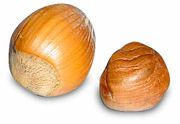Common Hazel
2007 Schools Wikipedia Selection. Related subjects: Plants
| iCommon Hazel | ||||||||||||||
|---|---|---|---|---|---|---|---|---|---|---|---|---|---|---|
 Common Hazel leaves and nuts
|
||||||||||||||
|
|
||||||||||||||
|
Secure
|
||||||||||||||
| Scientific classification | ||||||||||||||
|
||||||||||||||
|
|
||||||||||||||
| Corylus avellana L. |
The Common Hazel (Corylus avellana) is a species of hazel native to Europe and Asia. It is typically a shrub reaching 3-8 m tall, but can reach 15 m on occasion. The leaves are deciduous, rounded, 6-12 cm long and across, softly hairy on both surfaces, and with a double-serrate margin.
The flowers are produced very early in spring before the leaves and are monoecious, with single-sex catkins, the male pale yellow and 5-12 cm long, the female very small and largely concealed in the buds, with only the bright red 1-3 mm long styles visible. The fruit is a nut, produced in clusters of one to five together, each nut held in a short leafy involucre ('husk') which encloses about three quarters of the nut. The nut is roughly spherical to oval, 15-25 mm long and 12-20 mm broad, yellow-brown with a pale scar at the base. The nut falls out of the involucre when ripe, about 7-8 months after pollination. It is readily distinguished from the closely related Filbert (Corylus maxima) by the short involucre; in the Filbert the nut is fully enclosed by a beak-like involucre longer than the nut.
Common Hazel is used by a number of species of Lepidoptera as a food plant.
The name of the species, avellana is derived from Avellino, a place in Italy.
Cultivation and uses
The Common Hazel is an important component of the hedgerows that were the traditional field boundaries in lowland England. The wood was traditionally grown as coppice, the poles cut being used for wattle-and-daub building and agricultural fencing.

Common Hazel is cultivated for its nuts in commercial orchards in Turkey, Europe, China and Australia. The name "hazelnut" applies to the nuts of any of the species of the genus Corylus. This hazelnut or cobnut, the kernel of the seed, is edible and used raw or roasted, or ground into a paste. The seed has a thin, dark brown skin which has a bitter flavour and is sometimes removed before cooking. The top producer of hazelnuts, by a large margin, is Turkey. Turkish hazelnut production of 625,000 tonnes accounts for approximately 75% of worldwide production (World Hazelnut Situation and Outlook, USDA 2004).
In the United States, hazelnut production is concentrated in two states, Oregon and Washington; however, they are also grown extensively just to the north, in the Fraser Valley of British Columbia, Canada. In 1996 the production in Oregon was about 40,000 tonnes (in shell) compared to 200 tonnes in Washington. Recent orchard plantings in California are likely to increase production in the USA. The hazelnut is also growing in popularity in the USA with a Hazelnut Council set up to promote its use. The harvesting of hazelnuts is either by hand in rural communities, or by manual or mechanical raking of fallen nuts.
Hazelnuts are extensively used in confectionery to make praline and also used in combination with chocolate for chocolate truffles and products such as Nutella.
In Austria and especially in Vienna hazelnut paste is an important ingredient in the world famous torts (such as Viennese hazelnut tort) which are made there.
Hazelnut is also becoming popular as an addition to the range of coffees drunk by the modern café society with Hazel latte becoming popular. The popularity of Hazelnut liqueur, based on a vodka, is now increasing especially in eastern Europe.
In the USA production of hazelnut butter is seen as an alternative, tasty and more nutritious than its peanut butter counterpart.
In Australia over 2000 tonnes are imported annually mostly to supply the demand from the Cadbury company for inclusion in its eponymous milk chocolate bar which is the third most popular brand in Australia. Hazelnut oil, pressed from hazelnuts, is strongly flavoured and used as a cooking oil.
Hazelnuts are also grown extensively in Australia in orchards growing varieties mostly imported from Europe.
| Hazelnuts (edible parts) Nutritional value per 100 g |
||||||||||||||||||||||||||
|---|---|---|---|---|---|---|---|---|---|---|---|---|---|---|---|---|---|---|---|---|---|---|---|---|---|---|
| Energy 630 kcal 2630 kJ | ||||||||||||||||||||||||||
|
||||||||||||||||||||||||||
| Percentages are relative to US recommendations for adults. Source: USDA Nutrient database |
||||||||||||||||||||||||||
Hazelnuts are rich in protein and unsaturated fat. Moreover, they contain significant amounts of thiamine and vitamin B6, as well as smaller amounts of other B vitamins. Additionally, for those persons who need to restrict carbohydrates, 250 ml of hazelnut flour has 20 g of carbohydrates, 12 g fibre, for less than 10 net carbohydrates.
There are many cultivars of the Hazel, including 'Barcelona', 'Butler', 'Casina', 'Clark' 'Cosford', 'Daviana', 'Delle Langhe', 'England', 'Ennis', 'Halls Giant', 'Jemtegaard', 'Lewis', 'Tokolyi', 'Tonda Gentile', 'Tonda di Giffoni', 'Tonda Romana', 'Wanliss Pride', and 'Willamette'. Some of these are grown for specific qualities of the nut including early and late fruiting cultivars, whereas other are gown as pollinators. The majority of commercial Hazelnuts are grown as grafts onto stock of the Turkish Hazel (Corylus colurna), because of its non suckering habit.



